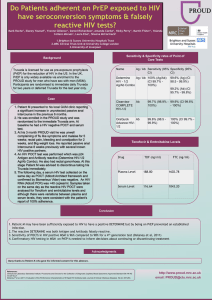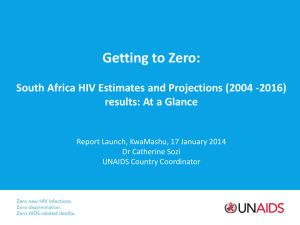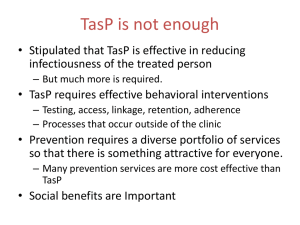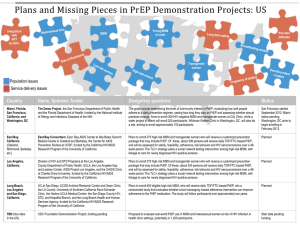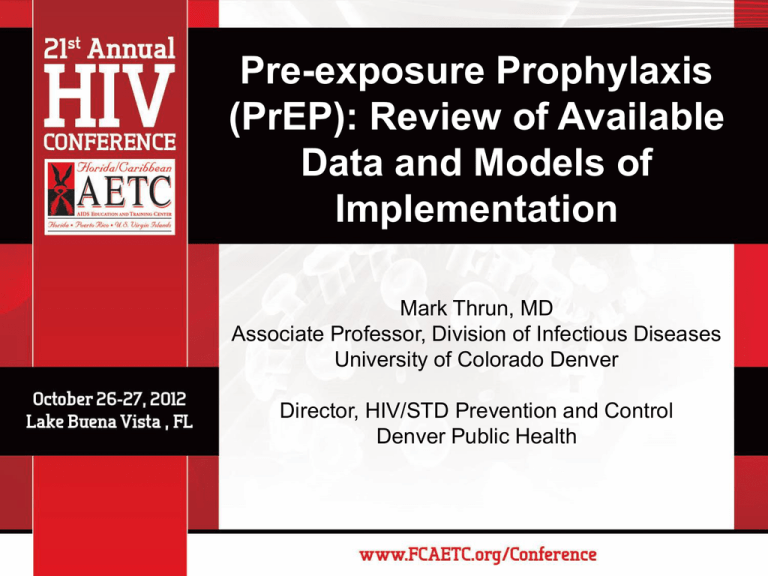
Pre-exposure Prophylaxis
(PrEP): Review of Available
Data and Models of
Implementation
Mark Thrun, MD
Associate Professor, Division of Infectious Diseases
University of Colorado Denver
Director, HIV/STD Prevention and Control
Denver Public Health
Disclosures of Financial Relationships
This speaker has no financial relationships
with commercial entities to disclose.
This speaker will not discuss any off-label
use or investigational product during the
program.
This slide set has been peer-reviewed to ensure that there are no
conflicts of interest represented in the presentation.
Objectives
• Provide an overview of human studies
utilizing systemic antiretrovirals (ARVs) as
PrEP
• Provide evidence of ARV agents used as
microbicides as PrEP
• Discuss barriers to the implementation of
PrEP
“No one knows whether PrEP will work. Even
if it does, it will need to be used in combination
with current HIV prevention methods,
including safer sex, use of male and female
condoms, treatment of sexually transmitted
infections, risk reduction counseling, clean
needles, and male circumcision. PrEP will
never be a silver bullet and will not replace
any of these current strategies.”
AIDS Vaccine Advocacy
Coalition – 2008
“No one knows whether PrEP will work. Even
if it does, it will need to be used in combination
with current HIV prevention methods,
including safer sex, use of male and female
condoms, treatment of sexually transmitted
infections, risk reduction counseling, clean
needles, and male circumcision. PrEP will
never be a silver bullet and will not replace
any of these current strategies.”
AIDS Vaccine Advocacy
Coalition – 2008
Courtesy Robert Grant, 2011
PrEP for conditions transmitted via sex
not new: Medical contraception
• Patient with knowledge of impending risk
• Seeks out provider recommendation and/or
prescription
• Opportunity for education
–
–
–
–
Pregnancy avoidance techniques
Side effects and risks of medication
Risks of pregnancy if non-compliant
Presentation of pregnancy if prophylaxis not
efficacious
NHBS Survey of MSM re: PrEP
To assess knowledge and attitudes towards PrEP in the
prevention of HIV among MSM.
Supplemental PrEP-specific questions were included in
the 2008 National HIV Behavioral Surveillance (NHBS)
cycle in Denver, CO
Analysis limited to participants who did not report being
HIV-positive
Descriptive frequencies presented
NHBS Overview
On-going surveillance activities conducted nationally in
rotating 12-month cycles in three populations at high risk
for HIV
Men who have sex with men (MSM)
Injection drug users (IDU)
High risk heterosexuals (HET)
Standardized core questionnaire across sites and
populations (+ optional local questions)
A minimum of 500 persons per metropolitan area
interviewed during each cycle
Anonymous and voluntary
National HIV Behavioral Surveillance System
CDC funded, 20+ participating sites
12 month cycles in 3 target populations
MSM2 cycle - 2008
IDU2 cycle - 2009
HET2 cycle - 2010
Venue-based sampling
Respondent-driven sampling
Respondent-driven sampling
Formative Research
Formative Research
Formative Research
Key Informant Interviews (N = 10)
Key Informant Interviews (N = 10)
• Key Informant Interviews (N = 10)
Focus Group Interviews (N = 30)
Focus Group Interviews (N = 30)
• Focus Group Interviews (N = 30)
Venue Identification
Seed Identification
• Seed Identification
Surveillance Activities
Surveillance Activities
Surveillance Activities
Anonymous survey (N = 500)
• Anonymous survey (N = 500)
• Anonymous survey (N = 500)
Voluntary and anonymous HIV
testing
• Voluntary and anonymous HIV
testing
• Voluntary and anonymous HIV
testing
NHBS-MSM2 (2008)
Venue-based, time-space sampling
Eligibility criteria:
- Male, at least 18 years of age
- Lives in the participating MSA
- Able to complete the interview in English or Spanish
- Not previously participated in NHBS-MSM2
Interviewer administered survey via handheld
ipaq
HIV testing:
- Rapid Oral OraQuick
- Confirmatory Oral OraSure
Result of most recent HIV test
NHBS-MSM2
N=612
N (%)
Negative
443 (72.4)
Positive
105 (17.2)
Never obtained results
24 (3.9)
Indeterminate
20 (3.3)
Refused to answer
Don’t know
5 (0.8)
15 (2.5)
Race / Ethnicity
NHBS-MSM2
N=507
N (%)
White, non-Hispanic
315 (62.1)
Black, non-Hispanic
19 (3.8)
Hispanic
Other*
138 (27.2)
35 (6.9)
* Asian, Pacific Islander, American Indian, and Alaskan Native
Education
NHBS-MSM2
N=507
N (%)
< High School
200 (39.4)
High School
158 (31.2)
> High School
149 (29.4)
Age
NHBS-MSM2
N=507
N (%)
18 – 24
93 (18.3)
25 – 34
143 (28.2)
35 – 44
126 (24.9)
45 – 54
88 (17.4)
≥ 55
57 (11.2)
PrEP Question Introduction
Scientists are currently doing studies to find
new ways of preventing people from becoming
infected with HIV. In these studies, people
take a pill every day that contains the same
medicine that is used to treat people who are
infected with HIV. Scientists want to know if
taking this medicine will prevent people
exposed to HIV from becoming infected with it.
They call this method pre-exposure
prophylaxis or PrEP.
Ever heard of PrEP before today?
NHBS-MSM2
N=507
N (%)
No
402 (79.3)
Yes
104 (20.5)
Don’t Know
1 (0.2)
Few or no side effects
If studies showed that PrEP has few or no
side effects, would you be willing to take
PrEP pills every day to try to protect yourself
from becoming infected with HIV?
NHBS-MSM2
N=507
N (%)
No
177 (34.9)
Yes
322 (63.5)
Don’t Know/Refuse
8 (1.6)
75% effective
If studies showed that PrEP prevents HIV infection in
three quarters or 75% of the people who take it,
would you be willing to take PrEP pills every day to
try to protect yourself from becoming infected with
HIV?
NHBS-MSM2
N=330
N (%)
No
Yes
Don’t Know/Refuse
36 (10.9)
288 (87.3)
6 (1.8)
50% effective
If studies showed that PrEP prevents HIV infection in
half or 50% of the people who take it, would you be
willing to take PrEP pills every day to try to protect
yourself from becoming infected with HIV?
NHBS-MSM2
N=294
N (%)
No
73 (24.8)
Yes
215 (73.1)
Don’t Know/Refuse
6 (2.1)
Low risk for infection
Please tell me if the following are reasons
why you might not consider taking PrEP:
Because you think you are at low risk for
HIV infection.
NHBS-MSM2
N=507
N (%)
No
Yes
Don’t Know/Refuse
254 (50.1)
246 (48.5)
7 (1.4)
Consistent condom use
Please tell me if the following are reasons
why you might not consider taking PrEP:
Because you use condoms consistently
NHBS-MSM2
N=507
N (%)
No
Yes
Don’t Know/Refuse
275 (54.2)
226 (44.9)
6 (1.2)
Condom use and PrEP
If you were taking PrEP pills every day, would
you use condoms less frequently, more
frequently, or about as frequently as before?
NHBS-MSM2
N=507
N (%)
Less frequently
More frequently
About as frequently
Don’t Know/Refuse
50 (9.9)
36 (7.1)
410 (80.9)
11 (2.2)
Sexual activity and PrEP
If you were taking PrEP pills every day, would
you have sex with fewer people, more people,
or about the same number of people?
NHBS-MSM2
N=507
N (%)
Fewer people
More people
Same number
Don’t Know/Refuse
22 (4.3)
23 (4.5)
454 (89.6)
8 (1.6)
How effective is oral pre-exposure
prophylaxis at prevention HIV?
47%
A. 39%
B. 44%
C. 63%
D. 73%
E. 91%
F. 100%
21%
16%
11%
5%
0%
A.
B.
C.
D.
E.
F.
iPrEx
• Males, > 18 years
• Normal renal and liver function
• Sexual risk in the last 6 months
– Unprotected anal intercourse with male partner with
HIV or HIV unknown male partner
– Anal sex with more than 3 males
– Exchange sex
– New STI
• Randomized to placebo or tenofovir/emtricitabine
every day
In addition to medication
• Monthly counseling
– Risk behavior
– Adherence
• Monthly HIV testing
• Frequent STD screening
Baseline demographics
NEJM, Nov 23, 2010: Courtesy Robert Grant, 2011
44% reduction in incident HIV in
treatment versus placebo arm
NEJM, Nov 23, 2010: Courtesy Robert Grant, 2011
Self-reported adherence associated
with efficacy
Effectiveness
> 90% adherence
73% (41-88%)
> 50% adherence
50% (18-70%)
NEJM, Nov 23, 2010: Courtesy Robert Grant, 2011
Detectable drug associated with
protection
Participants
Participants
who remained who became
HIV-negative HIV-positive
% with drug in
their blood
54%
8%
NEJM, Nov 23, 2010: Courtesy Robert Grant, 2011
PrEP very efficacious….if you can take it
NEJM, Nov 23, 2010: Courtesy Robert Grant, 2011
Effective across subgroups
NEJM, Nov 23, 2010: Courtesy Robert Grant, 2011
Nausea noted in some in 1st month
NEJM, Nov 23, 2010: Courtesy Robert Grant, 2011
Few side effects
NEJM, Nov 23, 2010: Courtesy Robert Grant, 2011
Resistance mutations
NEJM, Nov 23, 2010: Courtesy Robert Grant, 2011
Vaginal PrEP could rescue HIV
transmission by how much?
35%
A. 39%
B. 44%
C. 63%
20%
20%
16%
D. 73%
8%
E. 91%
0%
F. 100%
A.
B.
C.
D.
E.
F.
Microbicide Gel - Tenofovir
• Caprisa 004 study – double-blind RCT
• Tenovovir 1% gel vs. Placebo gel
• Gel was used intra-vaginally, peri-coitally –
within 12 hours before and 12 hours after sex
• Adherence determined as proportion of sexual
acts where a pre- and post-dose were
administered
• About 900 heterosexual women, South Africa
Karim, Science, 2010
CDC TDF2
• HIV negative partners of HIV-infected
persons randomized to TDF/FTC or placebo
– 599 Placebo: 24 infections
– 601 TDF/FTC: 9 infections
– 62.6% reduction in risk
– Sub-analysis of those with drug (<30 since last
pickup) : 78% reduction in risk
http://www.cdc.gov/nchhstp/newsroom/PrEPHeterosexuals.html
Kaplan-Meier time to HIV Infection
Placebo 60 infections, Tenofovir 38 infections
Karim, Science, 2010
UW Partners PrEP
• 4,758 HIV-negative partners of HIVinfected persons randomized to:
– Placebo: 47 infections
– TDF: 18 infections – 62% reduction
– TDF/FTC: 13 infections – 73% reduction
UW Partners PrEP
Baeten, NELM, 2012
Fem-PrEP
• Study of daily oral tenofovir/emtricitabine
in women
– Enrolled 1,951 women in Kenya, South Africa,
Tanzania
– Planned stop at 72 end points (HIV infection)
– New HIV infections at 5% per year
• Study discontinued at 56 endpoints
– 28 HIV infections each in control and treatment
arms
– Unlikely to achieve statistical significance
http://www.fhi360.org/en/Research/Projects/FEM-PrEP.htm
Reported condom use decreased in patients
on PrEP (in iPrEx) by how much?
A. 5%
B. 10%
C. 25%
D. 50%
43%
21%
19%
17%
A.
B.
C.
D.
No behavioral disinhibition
NEJM, Nov 23, 2010: Courtesy Robert Grant, 2011
Partners decreased
NEJM, Nov 23, 2010
Condom use increased
NEJM, Nov 23, 2010
More questions than answers
Who would be a high-risk person eligible
for PrEP?
• Risk category?
– MSM
– Heterosexuals
– Injection drug users
• Specific risk behaviors?
– Multiple partners
– Frequent unprotected anal or vaginal
intercourse
• Race/ethnicity?
Once eligibility is defined, how would
patients be identified?
• Patient self-referral?
– Challenge in getting the word out
– Marketing directly to patients
• Community based organization referral?
– CRCS plus PrEP
• Provider recommendation?
– Do providers ask enough about risk to even
know who is at high risk?
– Provider bias/attitudinal barriers
From what setting would PrEP be
prescribed?
• Subspecialists
– Currently most HIV meds are prescribed by HIV experts
comfortable with their use
– Many HIV care providers see few patients at risk for HIV
– Would HIV experts be willing to take this on?
• Primary care
– Would likely be the primary clinician caring for persons
at risk
– Would primary care clinicians be willing to take on this
role?
– Would the prescribing clinician be comfortable
counseling about risk?
What about patients not seen in care
regularly?
• 44 million people in the US without health
insurance
• What is the role of STD clinics – presumptively the
location in which many at-risk persons will
present?
• What is the role of other publicly funded entities?
Health departments, etc?
Who would pay?
• Tenofovir retail price for 30 days: $500-600
• Would insurance cover cost?
– Would identification of high risk place people at risk for
losing insurance?
• What about those without insurance?
• Would this create a two-tiered prevention program?
– Those with money vs. those without?
– Not dissimilar to nPEP
Who performs follow-up?
• Initial labs (e.g. Creat, Hep B screening)
• Side effect monitoring
– Discussion of symptoms
– Laboratory monitoring
• Discussions of adherence
• Potential for seroconversion
– How often HIV tested
– Is subsequent resistance an issue?
• When should therapy end?
– Monogamous relationship
Who provides ongoing risk behavior
counseling?
• Will meds result in higher risk behaviors?
• Literature from PEP suggests counseling
important
– Providers reticent to ask detailed questions
– Would mandatory risk discussions play a role?
• What about those patients that continue to put
themselves at risk?
– Should they continue to receive PrEP?
– Are they the ideal patient for PrEP?
• Education about episodic use (T dance, disco
dosing)
Pre-exposure prophylaxis for HIV
• Patient with knowledge of impending risk
• Seeks out provider recommendation and/or
prescription
• Opportunity for education
–
–
–
–
Disease avoidance techniques
Side effects and risks of medication
Risks of exposure to disease if non-compliant
Presentation of disease if prophylaxis not
efficacious
Guidance is available
(and planned)
• Formal HHS guidance due 2012
http://www.cdc.gov/hiv/prep/
Before PrEP
• Test for HIV
• Test for Acute HIV if any symptoms of
primary infection
• Confirm ongoing risk
• Check creatinine
During PrEP
• HIV test every 3 months
• Adherence counseling every visit
• Risk discussion and counseling every 3
months
• STI screening every 6 months
• Creatinine/BUN at 3 months and yearly
Discontinue PrEP
• Test for HIV
• Link into care if positive
Conclusions
• PrEP has enormous potential as a part
of our prevention armamentarium
• If:
– We are able to easily identify those at
highest risk
– Cost issues are addressed
– It is made part of a spectrum of prevention
services
• Formal HHS guidance will be helpful and
pending
“As we enter an era that could bring all
effective prevention tools, biomedical
and behavioral, together in a
concerted and integrated way, what’s
needed is a behavioral paradigm that
encompasses all these interventions
and the behaviors that underlie them.”
Kees Rietmeijer - 2010
Thanks
• Dawn Smith – CDC
• Robert Grant – UCSF
• Alia Al-Tayyib – DPH


